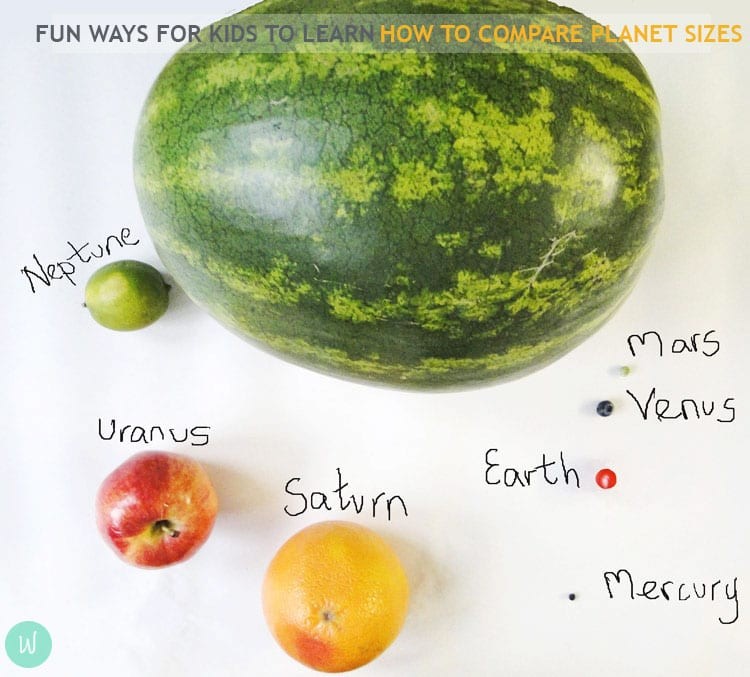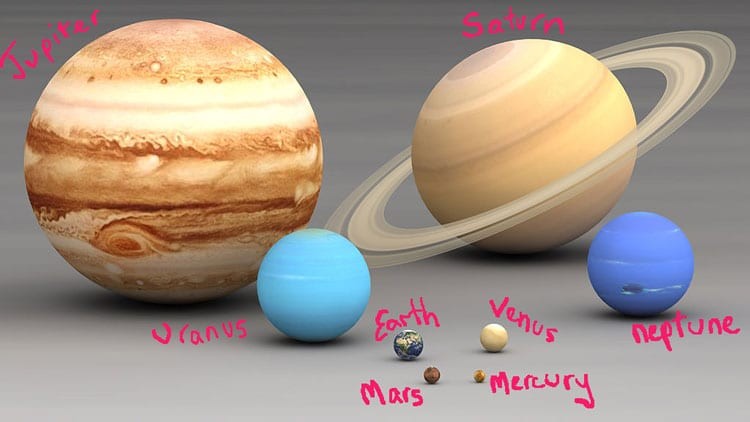Planets Compared In Size reveal the vast differences in our solar system, and COMPARE.EDU.VN offers a comprehensive overview. Understanding planetary dimensions sheds light on their composition, geological activity, and potential for harboring life, and we are here to provide a detailed comparison of these celestial bodies. Explore the relative scale of planets and uncover fascinating insights into their unique characteristics with us.
1. What Is the Order of the Planets by Size?
The order of the planets by size, from largest to smallest, is Jupiter, Saturn, Uranus, Neptune, Earth, Venus, Mars, and Mercury. Understanding this order helps visualize the immense scale differences within our solar system. Each planet’s size significantly influences its other characteristics, such as atmospheric composition and gravitational pull.
1.1 Jupiter: The Giant of the Solar System
Jupiter, the largest planet, dwarfs all others. Its immense size is a result of its composition, primarily hydrogen and helium, and its strong gravitational field. A fascinating fact is that Jupiter’s Great Red Spot, a persistent storm, is larger than Earth.
1.2 Saturn: The Ringed Beauty
Saturn, known for its spectacular rings, is the second-largest planet. Its rings are made of ice and rock particles. Although slightly smaller than Jupiter, Saturn’s size still vastly exceeds that of Earth.
1.3 Uranus and Neptune: The Ice Giants
Uranus and Neptune are often referred to as ice giants due to their composition, which includes icy materials like water, ammonia, and methane. Uranus is slightly larger than Neptune, but both are significantly smaller than Jupiter and Saturn.
1.4 Earth: Our Home Planet
Earth, our home, ranks fifth in size. It is the largest of the terrestrial planets, distinguished by its diverse environment, abundant water, and life-supporting atmosphere.
1.5 Venus: Earth’s Twin
Venus is often called Earth’s twin because of its similar size and composition. However, Venus has a dense, toxic atmosphere and extremely high surface temperatures, making it uninhabitable.
1.6 Mars: The Red Planet
Mars, often called the Red Planet due to its iron-rich surface, is smaller than Earth and Venus. It has a thin atmosphere and evidence of past water, making it a subject of intense scientific interest.
1.7 Mercury: The Smallest Planet
Mercury is the smallest planet and the closest to the Sun. Its small size and proximity to the Sun result in extreme temperature variations. Mercury’s surface is heavily cratered, resembling the Moon.
2. How Does Earth Compare to Other Planets in Size?
Earth is the fifth-largest planet in our solar system, larger than Mercury, Mars, Venus, and Neptune but smaller than Jupiter, Saturn, and Uranus. Compared to the gas giants, Earth is significantly smaller.
2.1 Earth vs. Jupiter
Jupiter is so massive that more than 1,300 Earths could fit inside it. The diameter of Jupiter is about 11 times that of Earth. This comparison underscores the vast scale difference between the two planets.
2.2 Earth vs. Saturn
Saturn is also much larger than Earth, with a diameter about 9.5 times greater. Despite its impressive rings, Saturn is less dense than Earth.
2.3 Earth vs. Uranus
Uranus has a diameter about four times that of Earth. Its unique feature is its axial tilt, which causes extreme seasonal variations.
2.4 Earth vs. Neptune
Neptune is slightly smaller than Uranus but still about 3.9 times the size of Earth. Its deep blue color is due to the absorption of red light by methane in its atmosphere.
2.5 Earth vs. Venus
Venus is often considered Earth’s twin due to its similar size, with a diameter about 0.95 times that of Earth. Despite their similar sizes, Venus has a dramatically different environment.
2.6 Earth vs. Mars
Mars is significantly smaller than Earth, with a diameter about 0.53 times that of Earth. Its smaller size contributes to its thinner atmosphere and lower gravity.
2.7 Earth vs. Mercury
Mercury is the smallest planet, with a diameter about 0.38 times that of Earth. Its small size and lack of atmosphere result in extreme temperature variations.
3. What Are the Diameter Comparisons of the Planets?
The diameters of the planets vary significantly, ranging from Mercury’s 4,879 km to Jupiter’s 142,984 km. Understanding these diameter differences helps visualize the relative sizes of the planets.
| Planet | Diameter (km) | Diameter (miles) |
|---|---|---|
| Jupiter | 142,984 | 88,846 |
| Saturn | 120,536 | 74,897 |
| Uranus | 51,118 | 31,763 |
| Neptune | 49,528 | 30,775 |
| Earth | 12,742 | 7,918 |
| Venus | 12,104 | 7,521 |
| Mars | 6,779 | 4,212 |
| Mercury | 4,879 | 3,032 |



3.1 Visualizing Planetary Diameters
To better understand the differences, imagine scaling down the planets. If Earth were the size of a basketball, Jupiter would be about the size of a small car, while Mercury would be about the size of a golf ball.
3.2 Diameter and Planetary Characteristics
A planet’s diameter often correlates with its mass, density, and gravitational pull. Larger planets tend to have stronger gravitational fields, which can retain thicker atmospheres.
4. How Does the Mass of Planets Compare?
The mass of the planets varies even more dramatically than their diameters. Jupiter’s mass is more than 300 times that of Earth, while Mercury’s is only about 5.5% of Earth’s.
| Planet | Mass (Earth = 1) | Mass (kg) |
|---|---|---|
| Jupiter | 317.8 | 1.898 × 10^27 |
| Saturn | 95.2 | 5.683 × 10^26 |
| Uranus | 14.5 | 8.681 × 10^25 |
| Neptune | 17.1 | 1.024 × 10^26 |
| Earth | 1 | 5.972 × 10^24 |
| Venus | 0.815 | 4.867 × 10^24 |
| Mars | 0.107 | 6.417 × 10^23 |
| Mercury | 0.055 | 3.301 × 10^23 |
4.1 Mass and Gravitational Influence
A planet’s mass directly influences its gravitational pull, which affects everything from its atmosphere to its ability to retain moons and rings.
4.2 Understanding Mass Discrepancies
The significant differences in mass between the gas giants and the terrestrial planets are due to their composition. Gas giants are primarily composed of lighter elements like hydrogen and helium, while terrestrial planets are made of heavier elements like iron and rock.
5. What Is the Significance of Comparing Planet Sizes?
Comparing planet sizes helps us understand the formation and evolution of our solar system, as well as the potential for life on other planets. It provides insights into planetary composition, atmospheric conditions, and geological activity.
5.1 Formation and Evolution
The size and mass of a planet are key factors in its formation and evolution. Larger planets have more gravitational pull, allowing them to accumulate more material during their formation.
5.2 Habitability
A planet’s size can also influence its habitability. Earth’s size is just right to maintain a stable atmosphere and liquid water on its surface, both crucial for life as we know it.
5.3 Understanding Planetary Processes
By comparing the sizes and masses of different planets, scientists can better understand the processes that shape planetary surfaces and atmospheres.
6. How Does Density Relate to Planet Size?
Density is another crucial factor when comparing planets. It is defined as mass per unit volume and provides insights into a planet’s composition.
| Planet | Density (g/cm^3) |
|---|---|
| Earth | 5.51 |
| Mercury | 5.43 |
| Venus | 5.24 |
| Mars | 3.93 |
| Neptune | 1.64 |
| Uranus | 1.27 |
| Saturn | 0.69 |
| Jupiter | 1.33 |
6.1 Density of Terrestrial Planets
The terrestrial planets (Mercury, Venus, Earth, and Mars) have higher densities because they are primarily composed of rock and metal.
6.2 Density of Gas Giants
The gas giants (Jupiter and Saturn) have lower densities due to their composition, which is primarily hydrogen and helium. Saturn is notably less dense than water.
6.3 Density of Ice Giants
The ice giants (Uranus and Neptune) have intermediate densities, reflecting their composition of heavier elements and icy materials.
7. What Are Some Visual Comparisons of Planet Sizes?
Visual comparisons can make the size differences between planets more understandable. One common method is to use everyday objects as analogies.
7.1 Fruit Analogy
- Jupiter: Watermelon
- Saturn: Large Grapefruit
- Uranus: Apple
- Neptune: Lime
- Earth: Cherry Tomato
- Venus: Large Blueberry
- Mars: Pea
- Mercury: Peppercorn
7.2 Basketball Analogy
If Earth were the size of a basketball:
- Jupiter: Would be about the size of a small car.
- Saturn: Would be slightly smaller than Jupiter.
- Uranus and Neptune: Would be about the size of large exercise balls.
- Mars: Would be about the size of a softball.
- Mercury: Would be about the size of a golf ball.
7.3 Graphic Representations
Visual representations, such as diagrams and illustrations, provide a clear comparison of planetary sizes.
8. How Does Surface Area Compare Between Planets?
Surface area is another important factor when comparing planets. It affects the amount of solar radiation a planet receives, as well as the potential for geological activity.
| Planet | Surface Area (million km^2) | Surface Area (million sq mi) |
|---|---|---|
| Jupiter | 61,420 | 23,710 |
| Saturn | 42,700 | 16,500 |
| Neptune | 7,618 | 2,941 |
| Uranus | 8,116 | 3,134 |
| Earth | 510 | 197 |
| Venus | 460 | 177 |
| Mars | 145 | 56 |
| Mercury | 75 | 29 |
8.1 Surface Area and Temperature
A planet’s surface area influences its temperature. Planets with larger surface areas can radiate heat more efficiently, potentially leading to lower average temperatures.
8.2 Surface Area and Geological Activity
The amount of surface area can also affect geological activity. Larger planets with more surface area may have more diverse geological features.
9. What Are Some Notable Features Related to Planet Size?
Planet size influences many aspects of a planet’s characteristics, including its atmosphere, magnetic field, and internal structure.
9.1 Atmosphere
Larger planets, like Jupiter and Saturn, have strong gravitational fields that allow them to retain thick atmospheres composed of light gases like hydrogen and helium.
9.2 Magnetic Field
A planet’s size and internal structure can influence its magnetic field. Earth’s magnetic field, generated by its liquid iron core, protects it from harmful solar radiation.
9.3 Internal Structure
The internal structure of a planet, including the size and composition of its core, mantle, and crust, is closely related to its overall size and mass.
10. How Do Exoplanets Compare in Size to Our Solar System’s Planets?
Exoplanets, planets orbiting stars other than our Sun, exhibit a wide range of sizes. Some are smaller than Mercury, while others are much larger than Jupiter.
10.1 Super-Earths
Super-Earths are exoplanets with masses higher than Earth’s but substantially below those of the Solar System’s ice giants, Uranus and Neptune. They are a common type of exoplanet.
10.2 Hot Jupiters
Hot Jupiters are gas giants similar in size to Jupiter but orbit very close to their stars, resulting in extremely high surface temperatures.
10.3 Mini-Neptunes
Mini-Neptunes are exoplanets smaller than Neptune but larger than Earth. They typically have thick atmospheres and may not have solid surfaces.
11. What Tools and Resources Can Help Compare Planet Sizes?
Several tools and resources can help visualize and compare planet sizes, from online simulators to educational books and models.
11.1 Online Simulators
Online simulators allow you to compare the sizes of different planets interactively. These tools often include detailed information about each planet’s characteristics.
11.2 Educational Books
Books like Professor Astro Cat’s Frontier of Space offer engaging ways to learn about planet sizes using relatable analogies and illustrations.
11.3 Physical Models
Physical models, such as scale models of the planets, provide a tangible way to understand size differences.
12. Why Is Understanding Planet Size Important for Space Exploration?
Understanding planet size is crucial for planning and executing space missions. It affects the amount of fuel needed to reach a planet, the type of spacecraft required, and the potential for landing and exploration.
12.1 Mission Planning
The size and mass of a planet influence the trajectory and fuel requirements for space missions. Larger planets have stronger gravitational fields, requiring more energy to escape.
12.2 Spacecraft Design
The type of spacecraft needed for a mission depends on the planet’s size and atmospheric conditions. Landing on a gas giant like Jupiter is impossible due to the lack of a solid surface.
12.3 Exploration Potential
Understanding planet size helps scientists assess the potential for exploration and the types of instruments needed to study a planet’s surface and atmosphere.
13. How Do Planetary Rings Relate to Planet Size?
Planetary rings, most famously seen around Saturn, are influenced by a planet’s size and gravitational pull.
13.1 Ring Formation
Rings are typically composed of ice and rock particles that have been captured by the planet’s gravity. The size and composition of the rings can vary depending on the planet.
13.2 Ring Stability
The stability of a ring system depends on the planet’s gravitational field and the presence of shepherd moons, which help to keep the ring particles in orbit.
13.3 Saturn’s Rings
Saturn’s rings are the most extensive and visible in our solar system. Their size and complexity are related to Saturn’s large size and strong gravitational field.
14. What Role Does Planet Size Play in Determining a Planet’s Atmosphere?
A planet’s size and mass are critical in determining the composition and density of its atmosphere.
14.1 Gravity and Atmospheric Retention
Larger planets with stronger gravitational fields can retain thicker atmospheres. The gas giants, Jupiter and Saturn, have massive atmospheres due to their size.
14.2 Atmospheric Composition
The size of a planet can also influence the composition of its atmosphere. Smaller planets, like Mars, have thinner atmospheres because they cannot retain lighter gases as effectively.
14.3 Temperature and Atmosphere
A planet’s size and distance from the Sun affect its temperature, which in turn influences its atmosphere. Venus, similar in size to Earth, has a very dense and hot atmosphere due to the greenhouse effect.
15. How Does a Planet’s Size Affect Its Geological Activity?
The size of a planet can influence its geological activity, including volcanism, plate tectonics, and erosion.
15.1 Internal Heat
Larger planets tend to retain more internal heat, which can drive geological activity. Earth’s internal heat drives plate tectonics and volcanism.
15.2 Plate Tectonics
Plate tectonics, the movement of a planet’s crustal plates, is influenced by the planet’s size and internal heat. Earth is the only planet in our solar system known to have active plate tectonics.
15.3 Erosion
Erosion, the wearing away of a planet’s surface by wind, water, and ice, is affected by the planet’s size and atmospheric conditions. Mars, with its thin atmosphere, experiences significant wind erosion.
16. What Are Some Unanswered Questions About Planet Size and Composition?
Despite our growing understanding of planets, many questions remain about their size, composition, and formation.
16.1 Formation of Gas Giants
The formation of gas giants like Jupiter and Saturn is still not fully understood. Scientists are working to understand how these planets accumulated so much gas.
16.2 Interior Structures
The interior structures of many planets, particularly the gas and ice giants, are not well known. Missions to these planets could provide valuable data.
16.3 Exoplanet Diversity
The diversity of exoplanets has raised many questions about planetary formation and evolution. Scientists are working to understand why some exoplanets are so different from the planets in our solar system.
17. How Do the Planets’ Rotation Speeds Compare?
The rotation speed of a planet can impact its shape, weather patterns, and magnetic field.
| Planet | Rotation Period (Earth Days) |
|---|---|
| Jupiter | 0.41 |
| Saturn | 0.44 |
| Uranus | 0.72 |
| Neptune | 0.67 |
| Earth | 1.00 |
| Mars | 1.03 |
| Venus | 243.0 |
| Mercury | 58.6 |
17.1 Fast Rotators
Gas giants like Jupiter and Saturn have very short rotation periods, leading to their slightly flattened shapes and strong weather patterns.
17.2 Slow Rotators
Venus and Mercury have very slow rotation periods. Venus’s slow rotation is particularly unusual and may be due to tidal forces or atmospheric effects.
17.3 Rotation and Magnetic Fields
A planet’s rotation speed is related to its magnetic field. Fast-rotating planets with electrically conductive interiors tend to have strong magnetic fields.
18. What is the Role of Size in a Planet’s Ability to Support Life?
A planet’s size significantly influences its ability to support life as we know it. Factors such as gravity, atmospheric retention, and internal heat are all linked to size.
18.1 Gravity and Liquid Water
A planet must be massive enough to retain a sufficient atmosphere to maintain liquid water on its surface. Liquid water is essential for life as we know it.
18.2 Atmospheric Composition
A planet’s size affects its ability to retain an atmosphere with the right composition for life. Earth’s atmosphere, with its balance of nitrogen, oxygen, and other gases, is crucial for life.
18.3 Internal Processes
A planet’s internal processes, driven by its size and internal heat, can affect its habitability. Plate tectonics, for example, helps regulate Earth’s temperature and recycle nutrients.
19. How Do Tidal Forces Relate to Planet and Moon Sizes?
Tidal forces, the gravitational forces exerted by a planet or moon on another object, are influenced by their sizes and distances.
19.1 Tidal Locking
Tidal locking occurs when a smaller object, like a moon, has its rotation slowed until it matches its orbital period around the larger object, like a planet. This is why the same side of the Moon always faces Earth.
19.2 Tidal Heating
Tidal heating occurs when tidal forces cause a moon to flex and stretch, generating heat inside. This process is thought to be responsible for the volcanic activity on Jupiter’s moon Io.
19.3 Ring Systems and Tidal Forces
Tidal forces can also play a role in the formation and maintenance of ring systems around planets.
20. What Future Missions Aim to Study Planet Sizes and Composition?
Several future space missions are planned to study the sizes, compositions, and other characteristics of planets in our solar system and beyond.
20.1 Europa Clipper
The Europa Clipper mission, planned by NASA, will study Jupiter’s moon Europa to assess its potential habitability. Understanding Europa’s size and composition is crucial to this mission.
20.2 Dragonfly
The Dragonfly mission, also by NASA, will send a rotorcraft lander to Saturn’s moon Titan. Titan’s size, atmosphere, and surface features make it a unique and interesting target for exploration.
20.3 James Webb Space Telescope
The James Webb Space Telescope (JWST) is being used to study the atmospheres of exoplanets, providing insights into their sizes, compositions, and potential habitability.
Understanding the relative sizes of planets is fundamental to astronomy and planetary science. It offers insights into their formation, composition, and potential for supporting life. COMPARE.EDU.VN aims to provide you with comprehensive comparisons of various aspects of planets, helping you make informed decisions and deepen your understanding of the cosmos.
Ready to explore the universe further? Visit COMPARE.EDU.VN at 333 Comparison Plaza, Choice City, CA 90210, United States, or contact us via Whatsapp at +1 (626) 555-9090.
FAQ: Planets Compared In Size
1. Which is the largest planet in our solar system?
Jupiter is the largest planet in our solar system, with a diameter of 142,984 km. Its massive size allows it to hold more than 1,300 Earths inside.
2. How does Earth’s size compare to Venus?
Earth and Venus are similar in size, with Venus having a diameter of 12,104 km compared to Earth’s 12,742 km. Despite their similar sizes, their environments are vastly different.
3. What is the smallest planet in our solar system?
Mercury is the smallest planet in our solar system, with a diameter of 4,879 km. Its small size contributes to extreme temperature variations on its surface.
4. Are Uranus and Neptune similar in size?
Yes, Uranus and Neptune are quite similar in size. Uranus has a diameter of 51,118 km, while Neptune’s diameter is 49,528 km.
5. How does planet size affect its atmosphere?
A planet’s size and mass determine its ability to retain an atmosphere. Larger planets with stronger gravity can hold thicker atmospheres, while smaller planets have thinner atmospheres.
6. What role does density play in comparing planet sizes?
Density helps determine the composition of a planet. Terrestrial planets are denser due to their rocky and metallic composition, while gas giants are less dense due to their composition of lighter gases.
7. Why is comparing planet sizes important for space exploration?
Understanding planet sizes is crucial for mission planning, spacecraft design, and assessing the potential for exploration. It affects fuel requirements, the type of spacecraft needed, and exploration strategies.
8. How does planet size affect its geological activity?
Larger planets tend to retain more internal heat, which drives geological activity such as volcanism and plate tectonics.
9. What are Super-Earths?
Super-Earths are exoplanets with masses higher than Earth’s but substantially below those of the Solar System’s ice giants, Uranus and Neptune, often studied to understand potential habitability.
10. Where can I find more detailed comparisons of planet sizes?
Visit compare.edu.vn for comprehensive comparisons of planet sizes, masses, densities, and other characteristics, helping you deepen your understanding of the cosmos.
